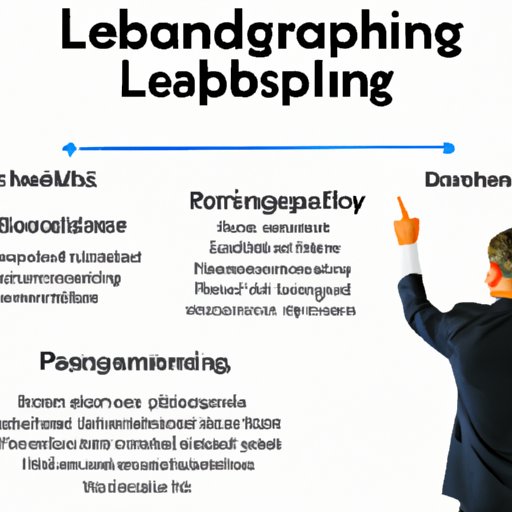Introduction
Leadership behavior is a set of actions that demonstrate the ability of an individual to lead and inspire others. It encompasses a wide range of behaviors, from inspiring and motivating team members to setting clear goals and holding people accountable for their performance. Leadership behaviors can be learned and developed over time, and there are a variety of strategies and techniques for doing so. In this article, we’ll explore what leadership behavior is, define different types of leadership behaviors, examine the characteristics of effective leaders, and discuss the benefits of leadership training.

Defining Leadership Behaviors: What They Are and How to Implement Them
Leadership behaviors are the actions taken by an individual to influence and motivate others. These behaviors can include setting clear goals, delegating tasks, providing feedback, and rewarding positive performance. Leaders must also be able to effectively communicate with their team and establish trust and respect among members. There are several types of leadership behaviors, such as transactional, transformational, charismatic, and servant leadership. Each type has its own set of behaviors and strategies for implementation.
Transactional leadership is focused on maintaining the status quo and following established procedures. This type of leadership involves setting expectations and providing rewards or punishments based on performance. Transformational leadership is more focused on inspiring and motivating team members to reach their full potential. Charismatic leadership is characterized by an individual’s personal magnetism and enthusiasm, which can be used to influence others. Finally, servant leadership is based on a leader’s commitment to serving their team and helping them achieve their goals.
In order to effectively implement leadership behaviors, leaders must understand their team members’ needs and motivations. Leaders should also be willing to adapt their leadership style to meet the changing needs of their team. Additionally, leaders should strive to create an environment where team members feel comfortable expressing their ideas and opinions. Finally, leaders should focus on building relationships with their team members and fostering collaboration.
Understanding Different Leadership Styles and the Impact They Have on Teams
Leadership styles refer to the way a leader interacts with and influences their team. Common leadership styles include autocratic, democratic, laissez-faire, and situational. Autocratic leaders make all the decisions without any input from their team. Democratic leaders involve their team in the decision-making process. Laissez-faire leaders give their team a lot of freedom and autonomy. Finally, situational leaders adjust their leadership style depending on the situation.
Different leadership styles can have a significant impact on team dynamics and performance. Autocratic leaders may stifle creativity and innovation, while democratic leaders may foster collaboration and encourage team members to think outside the box. Laissez-faire leaders may lead to confusion and lack of direction, while situational leaders may be able to better respond to the changing needs of their team.

Examining the Characteristics of Effective Leaders
Effective leaders possess certain qualities that enable them to lead their teams effectively. Qualities of an effective leader include strong communication skills, the ability to delegate tasks, the ability to think strategically, a sense of integrity and fairness, and the ability to inspire and motivate others. Additionally, effective leaders must be able to make difficult decisions, manage conflicts, and take responsibility for their team’s successes and failures.
There are many examples of effective leadership throughout history. Nelson Mandela is widely considered to be one of the most effective leaders of all time. He was able to unite a divided country through his vision and courage, and he inspired millions of people around the world with his words and actions. Another example is Mahatma Gandhi, who led India’s fight for independence from British rule. His peaceful protests and non-violent tactics were influential in the success of the Indian independence movement.

Exploring Examples of Great Leadership in History
Throughout history, there have been many great leaders who have had a lasting impact on the world. Notable historical leaders include Julius Caesar, Alexander the Great, Abraham Lincoln, and Winston Churchill. These leaders have left us with valuable lessons about the power of leadership. For example, Julius Caesar taught us the importance of having a clear vision and strategy, while Alexander the Great demonstrated the value of staying focused and determined in the face of adversity. Abraham Lincoln showed us the importance of being resilient and having the courage to stand up for what is right. Finally, Winston Churchill taught us the importance of perseverance and never giving up, no matter how daunting the odds.

Analyzing the Benefits of Leadership Training
Leadership training can help individuals develop the skills and knowledge needed to become effective leaders. Leadership training can provide individuals with the tools and techniques to improve their communication, problem-solving, and decision-making skills. Additionally, leadership training can help individuals understand the different types of leadership styles and how to use them effectively. Furthermore, leadership training can help individuals identify their strengths and weaknesses and develop a plan for improvement.
There are a variety of leadership training programs available, including group workshops, online courses, and one-on-one coaching. Group workshops can be beneficial for those who want to learn from peers and gain insight into different perspectives. Online courses provide individuals with the flexibility to learn at their own pace. Finally, one-on-one coaching can be helpful for those who need personalized guidance and feedback.
Debating the Value of Hierarchical Leadership Structures
Hierarchical leadership structures are often seen as outdated and inefficient, but they can still be beneficial in certain circumstances. On the one hand, hierarchical leadership structures can provide clarity and structure to an organization. They can also help ensure that decisions are made in an efficient and timely manner. On the other hand, hierarchical leadership structures can lead to a lack of innovation and creativity, as well as an increased risk of micromanagement.
Comparing Traditional Leadership Models with Modern Approaches
Traditional leadership models are typically based on top-down authority and rigid rules. Modern leadership models, on the other hand, emphasize collaboration, creativity, and flexibility. Traditional models emphasize the importance of the leader, while modern models emphasize the importance of the team. Traditional models focus on command and control, while modern models focus on empowering team members. Finally, traditional models focus on short-term results, while modern models focus on long-term growth and development.
Conclusion
Leadership behavior is a set of actions that demonstrate the ability of an individual to lead and inspire others. Different types of leadership behaviors can be implemented, such as transactional, transformational, charismatic, and servant leadership. Additionally, different leadership styles can have a significant impact on team dynamics and performance. Effective leaders possess certain qualities, such as strong communication skills and the ability to delegate tasks. Finally, leadership training can help individuals develop the skills and knowledge needed to become effective leaders.
(Note: Is this article not meeting your expectations? Do you have knowledge or insights to share? Unlock new opportunities and expand your reach by joining our authors team. Click Registration to join us and share your expertise with our readers.)
